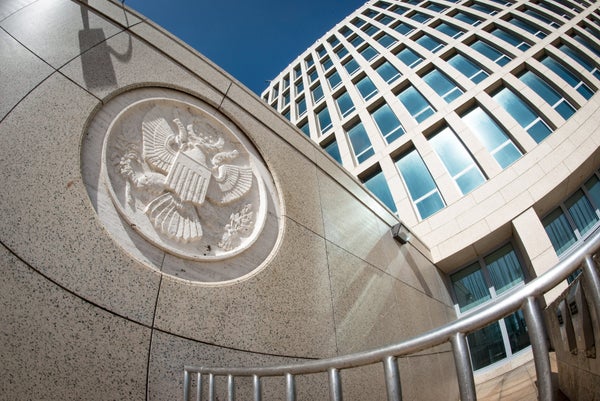This article was published in Scientific American’s former blog network and reflects the views of the author, not necessarily those of Scientific American
It reads like a bad spy thriller. Between November 2016 and October 2017, a strange illness afflicted 24 diplomatic staff members working at the U.S. embassy in Havana, Cuba. Employees reported symptoms such as headaches, confusion, hearing loss. They talked about hearing strange sounds, triggering speculation the Cubans were employing a new acoustic weapon to harass embassy employees. Other scientists dismissed the idea of a sonic weapon as impractical.
On September 1 science reporter William Broad jumped into this morass with a long article in The New York Times. His theory: the Cubans were employing a microwave weapon against U.S. embassy employees, causing sonic delusions and “very real brain damage”. He based his theory on the microwave auditory effect, in which pulses of microwave energy of the sort emitted by radar elicits auditory sensations in exposed individuals.
As the scientist who first proposed the now-accepted explanation of the effect in my 1974 Science article, I find the theory wildly implausible. To elicit auditory sensations, individuals must be exposed to intense but brief (microsecond) pulses of microwave energy. The pulses are sufficient to heat brain tissue by a few microdegrees in a few microseconds, and the resulting thermal expansion launches an acoustic wave in the brain that the subject perceives as sound. The acoustic pressures are many orders of magnitude too weak to cause tissue damage. They elicit audible sensations only because of the exquisite sensitivity of the human auditory system, and represent a near-threshold hearing phenomenon. To actually damage the brain, the microwaves would have to be so intense they would actually burn the subject, which has never happened in any of these incidents.
On supporting science journalism
If you're enjoying this article, consider supporting our award-winning journalism by subscribing. By purchasing a subscription you are helping to ensure the future of impactful stories about the discoveries and ideas shaping our world today.
To induce such an effect, one could cobble together a device from a military radar set or a commercial microwave generator, such as the one I used in my original experiments, and then direct a beam at a distant target. But the difficulty of aiming the beam at a person’s head some distance away would be daunting. You would have to know exactly where the victim’s head is located. You could use a much higher power radar such as that used for airport traffic control and spray the beam over a wide area, but the equipment then would be very large and cumbersome. Microwave antennas could also be embedded within the embassy walls, along with some kind of aiming device, but they would be easy to detect.
But why bother with a device that produces near-threshold hearing sensations? There are simpler ways to harass people if that is the goal. Even now, a year after the incidents were reported, the facts of the matter remain unclear. A follow-up medical examination of 21 of the affected individuals by a neuroscience group led by Doug Smith at the University of Pennsylvania (my colleagues, in fact) found equivocal evidence the individuals had sustained “injury to widespread brain networks”. Neuroskeptic, a neuroscientist who blogs anonymously in Discover magazine, brutally reviewed the Penn study. The blogger and other critical scientists suggested the findings were statistical artifacts due to the many tests the Penn group employed on the subjects. Other scientists have argued psychological factors were involved instead. Taken together, the results seem too scattered to allow firm conclusions to be drawn.
In October 2017 Josh Lederman and Michael Weissenstein from the Associated Press made recordings available of the sounds that the employees reported hearing. If those indeed were the sounds, that would rule out the microwave auditory effect where the microwave-induced vibrations exist only within the head. Chen Yan, Kevin Fu and Wenyuan Xu (of Zhejiang University and the University of Michigan) showed the sounds in the AP recordings are characteristic of those produced by the interaction of two inaudible ultrasound beams via an effect known as intermodulation distortion. Ultrasound is widely used in burglar detectors, room occupancy sensors and other increasingly common appliances, and some individuals report unpleasant audible sensations from such devices. Intermodulation distortion is increasingly being employed to jam microphones used to record concert music illegally or for eavesdropping. Yan and colleagues report ultrasound can be used for eavesdropping purposes as well, by picking up vibrations in objects produced by human speech.
In short, it is reasonable to guess the sounds were inadvertently produced by ultrasound devices, possibly even spy tech, but without malicious intent against the embassy personnel. The incidents occurred about the time of the 2016 U.S. election, and the Cubans undoubtedly were desperate for intelligence about U.S. intentions.
There is even a historical parallel to the recent incidents: In 1972 it became publicly known the Soviets had been irradiating the U.S. embassy in Moscow with low-level microwave energy from the 1950s through the 1970s. Neither side disclosed the reason for this. (A reasonable guess is the Russians were trying to disrupt U.S. listening equipment or to collect data from their own bugs in the building.) The media published hyperbolic stories about supposed attempts to harm the embassy staff, fueling a generation of speculation about microwave “neurowarfare.”
We don’t know all the facts about the earlier incidents or the current ones, and no government is likely to provide them. Much of the information available is distinctly anecdotal. The Times story is not “fake news” but the real facts of the matter may be quite different from those presented by its distinguished journalist.
